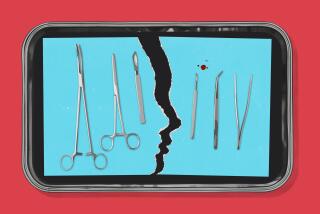Inaction by regulators as weight loss surgery allegations mount

Several current or former workers for the people behind those 1-800-GET-THIN ads have made allegations about this weight-loss enterprise that government regulators should have gotten to the bottom of long ago. Taken together, the allegations are that its patients are subjected to life-threatening conditions.
The regulators can’t ignore this situation anymore.
The workers include Dyanne Deuel, a former manager at surgery centers affiliated with the GET-THIN marketing campaign, and Karla Osorio, a surgical technician. They filed a whistle-blower lawsuit last week alleging their employers retaliated against them for reporting unsafe and unsanitary conditions at outpatient clinics affiliated with 1-800-GET-THIN.
The third worker is Ihsan Shamaan, a surgeon whose deposition, filed in a separate lawsuit, makes allegations of fraud, subornation of perjury and dangerous surgical practices in great detail.
The lawsuit from Deuel and Osorio points the finger at Julian and Michael Omidi, whom they identify as the impresarios behind 1-800-GET-THIN and the network of surgical clinics to which callers to the 800 number are referred for weight loss surgery — chiefly implantation of Allergan Inc.’s Lap-Band, a silicone ring cinched around the stomach to suppress food intake.
The Omidis haven’t responded to requests for comment on the whistle-blower case. They and other defendants are contesting the separate case, which was brought by relatives of two deceased GET-THIN patients and other plaintiffs.
As I’ve been reporting for nearly two years, Julian Omidi’s medical license has been revoked by the California medical board. In October, Michael Omidi completed three years of disciplinary probation ordered by the medical board.
We’ve also reported on five patients who have died since 2009 following Lap-Band procedures in clinics in Beverly Hills and West Hills affiliated with the GET-THIN marketing campaign, according to coroners’ reports, lawsuits and other public documents.
Shamaan in his deposition says he knows of six or seven deaths that occurred prior to Oct. 6, 2010, when he says he quit working for the Omidis. Because two of the reported deaths occurred after that date, including one still under investigation by the Los Angeles coroner (that of Paula Rojeski, whose death last Sept. 8 occurred after she underwent a Lap-Band operation at the Omidis’ Valley Surgical Center in West Hills) the known toll could be nine.
Brian Oxman, an attorney for 1-800-GET-THIN, went before the Los Angeles County Board of Supervisors a few weeks ago and declared that the doctors and surgical facilities it deals with are the “best of the best.” The conditions described in the whistle-blower lawsuit and by Dr. Shamaan don’t resemble the “best of the best.” They more resemble a charnel house.
The allegations in the whistle-blower lawsuit and in Shamaan’s deposition suggest that a major public health crisis has erupted in California right under the noses of the state medical board and the state Department of Public Health.
The problem isn’t that these regulators have been unaware of what takes place in the dark world behind the GET-THIN come-ons plastered all over freeway billboards, on the sides of buses, on the Internet, and on radio and TV. On the contrary, what gives the lawsuits so much credibility is how closely they hew to what regulators have long known or should have known about the Omidis and their business enterprises, based on public records.
The Deuel-Osorio lawsuit offers abhorrent details about unsanitary conditions and unprofessional behavior at the surgery clinics: The reuse of disposable instruments. The lack of adequate supplies. The flouting of sound sterilization practice, exposing patients to the risk of infection.
Yet inspectors from the state Department of Public Health documented such conditions way back in May 2009, following an unannounced visit to the Beverly Hills facility at 9001 Wilshire Blvd. The surgical suite was known then as Almont Ambulatory Surgery Center, but it was then under the control of the Omidis, as it still is, according to the lawsuit.
On that occasion the inspectors needed 22 pages to list all the health and safety violations they found. But the agency didn’t bother to shut the facility down. Nor do regulatory records indicate that it ever again conducted an unannounced inspection of that facility or any other under the Omidis’ control or management.
Deuel and Osorio allege that staffers at the facilities regularly perform medical duties for which they’re not properly trained or licensed. That can’t come as a surprise to the medical board. The board in 2007 formally accused Michael Omidi of allowing unlicensed employees to practice medicine at his clinic in West Hills, including allowing them to suture patients and in one case even perform liposuction.
In 2008 the board disposed of these accusations and others, which could have ended Omidi’s career, by allowing him to stipulate to violating a couple of legal provisions related to operating in an unaccredited surgical setting. It placed him on three years of probation.
What else have the medical board and public health department been doing all this time? They’ve been dodging responsibility for keeping an eye on non-hospital outpatient surgical settings like the Omidis’. You see, a state appeals court ruled in 2007 that regulatory authority over clinics owned by a doctor belonged to the medical board, not the public health department. Unfortunately, the medical board says it doesn’t have the resources or expertise to be watchdogs over physical facilities, only over doctors. (Public records have identified the doctor-owner of the Beverly Hills and West Hills facilities as Michael Omidi.)
The court decision tore an enormous hole in the state’s medical regulatory fabric, so you’d think the regulators and state legislators would have moved heaven and earth to fill it in. But no. In the more than four years since that ruling, nothing’s been done to either return regulatory authority to the public health agency, or get the medical board the tools it needs to do its job.
Last year, when I asked medical board President Barbara Yaroslavsky (wife of Los Angeles County Supervisor Zev Yaroslavsky) why she wasn’t screaming from the rooftops about her agency’s problems, she explained that she didn’t think it was right to “act independently” from the governor’s office, which sets her budget.
In other words, she thought it was more important to be seen as a team player politically than to live up to her responsibilities to the state’s surgical patients. That’s an explanation, of sorts, but the regulatory approach it describes is inexplicable.
Who else has blood on their hands in connection with these surgery centers?
How about health insurers?
Much of the income collected by the Omidis — Shamaan testified he was told it amounts to $21 million a month — comes from insurance payments. Yet the whistle-blowers’ lawsuit is rife with assertions of fraudulent billings. In the wrongful death case, Dr. Shamaan testified that at Julian Omidi’s direction he signed 600 fraudulent form letters seeking pre-authorizations for surgeries.
The health insurance industry justifies its existence by maintaining that we need its skill at ferreting out fraud and keeping medical bills reasonable. Lots of good they’ve done us in this instance.
The insurers aren’t shy about telling patients with legitimate conditions that they can’t spend an extra day or two in the hospital, but judging from the allegations in the whistle-blower lawsuit and others, not to mention Shamaan’s testimony, they may have paid out thousands of dollars, even millions, on inflated or fake claims from clinics affiliated with 1-800-GET-THIN. Think about that the next time your health insurer tries to explain why your premiums are being jacked up, again.
Then there’s the accreditation agency known as the Joint Commission, which has given its seal of approval to the Omidis’ Beverly Hills and West Hills surgery centers. The Joint Commission is one of the independent organizations to which the California medical board has outsourced the duty to inspect and oversee the non-hospital surgical facilities it inherited after that 2007 court ruling.
When the Joint Commission first accredited the Beverly Hills facility in September 2009 — by then the former Almont Ambulatory Surgery Center was doing business under the name Beverly Hills Surgery Center — the location’s accreditation already had been revoked by one competing accreditation organization and its application had been rejected by another.
But the Joint Commission didn’t examine a facility’s prior accreditation record as part of its approval process. Why not? It pockets an annual fee from its accredited institutions, so perhaps it has an incentive not to be too particular.
The state Legislature finally closed this loophole last year. Henceforth, a revocation by any one accreditation organization will have to be honored by all. But it’s proper to ask whether the Joint Commission has adequately performed its oversight function.
In her lawsuit Deuel, who says she based her account on information from people on the scene, describes frenzied efforts at the West Hills clinic to cover up the circumstances of Paula Rojeski’s death — defective equipment removed from the facility and spirited into hiding, the place scrubbed down, records falsified.
This all took place, Deuel says, prior to a pre-announced inspection by state and county officials looking into Rojeski’s death. But what if there had been an unannounced inspection by regulators, at any time before Rojeski went under the knife last Sept. 8? The conditions described by Deuel might have been discovered on the spot, like those discovered in Beverly Hills by the surprise inspection in 2009.
And Paula Rojeski might be alive today.
Let us now call the roll of the known departed. Willie Brooks, 1974-2009. Ana Renteria, 1976-2010. Laura Lee Faitro, 1959-2010. Tamara Walter, 1958-2010. Paula Rojeski, 1955-2011. According to coroners’ reports, lawsuits and other public documents, they all died after undergoing Lap-Band surgery at clinics associated with 1-800-GET-THIN.
The allegations in last week’s court filings point to the reasons why this may have happened, and to who looked away and let it happen.
One can only hope that the regulators and all the others who could have acted and failed to do so are haunted by these names to the end of their days. They should act now, before the roll call of victims grows longer.
Michael Hiltzik’s column appears Sundays and Wednesdays. Reach him at mhiltzik@latimes.com, read past columns at latimes.com/hiltzik, check out facebook.com/hiltzik and follow @latimeshiltzik on Twitter.







